



Ryan Bishop, Kristoffer Gansing, Jussi Parikka & Elvia Wilk (eds.) across and beyond: A transmediale Reader on Post-digital Practices, Concepts, and Institutions, Sternberg Press, 2017, pp.352, €15.00 (paperback), ISBN 978-3-95679-289-2
Although the notion of the “post-digital” has gained some prominence in media art and theory, the uptake of the term in the humanities and social sciences has so far been more muted: whilst the field of “post-digital” art scholarship is by no means new (see Berry & Dieter, 2015), the term itself is often used quite sparsely and ambiguously such that it risks becoming a vague referent for almost any form of human and nonhuman entanglement with media. This rich collection of 25 essays and artwork contributions, many from world-renowned artists and media theorists, seeks to remedy this by developing the notion of the “post-digital” as something that gains specific expression through certain kinds of critical practice. As the editors note in the introduction, across & beyond does so by focussing on the “post-digital conditions for critical media practices…for understanding and working in the transversal territories between theory, technology, and art” (p.5). Organised around a series of contributions presented in recent years by participants of the annual transmediale festival in Berlin, the transversal explorations in this reader are critical insofar as they aim to engage with the “material complexities of digital culture” beyond what the editors describe as the “phantasm” of the supposed “immaterial reality” of digital media (p.16).
To be clear, across & beyond is not strictly a theory book but a gathering of diverse academic and artistic contributions that variously approach questions concerning the “post-digital”. Some of the stakes of “post-digital” media theory are set out in this reader, and will be noted in this review, but it should be said that this is not merely a theoretical intervention into technological media.
The “post-digital” describes a set of “speculative strategies and poetics” (p.13) that act as a “heuristic to understand the historical and material contexts of media art and culture” (p.12). In this sense the “post-” of “post-digital” does not designate a temporal period after a bygone ‘Digital Age’, but instead describes an opening up of a whole “field for material but also imaginary, alternative practices” (p.13) that concern the different temporalities and spaces produced through and with media. The post-digital, then, is presented here as a field of study into the material and imaginary practices of media, which aims to offer “new means of critically linking technology, culture and nature” (p.15).

To thematise some of these traversal territories for thinking about the post-digital conditions of media, the essays and artworks in this reader are split into three themed subsections: “Imaginaries,” “Interventions,” and “Ecologies.” Rather than organising this review by treating each individual chapter, I will instead briefly suggest how certain chapters develop each of these three themes, and end by reflecting on how these themes intervene in the political stakes of social scientific engagements with digital media more widely.
At least in part, the first subsection – “Imaginaries” – develops a number of responses to the idea that the post-digital would be a field of study that rethinks the relationship between technological culture and time (see especially chapters by Gansing; Ludoivo; Daniels; Parikka; Menkman). In the opening chapter, Kristoffer Gansing develops the ‘problem of time’ for post-digital approaches to media by analysing the CD-ROM as a noteworthy “offline art form” (p.41). Rather than thinking about the CD-ROM as a redundant media of a bygone era, Gansing instead highlights the way that the “offline experience” (p.36) of the CD-ROM counters certain contemporary structures of digital surveillance. This intervention is post-digital, perhaps, insofar as the CD-ROM is seen to present specific opportunities for disrupting both processes of online surveillance, but also the reductive tendency to rush towards new, à la mode forms of digital media.
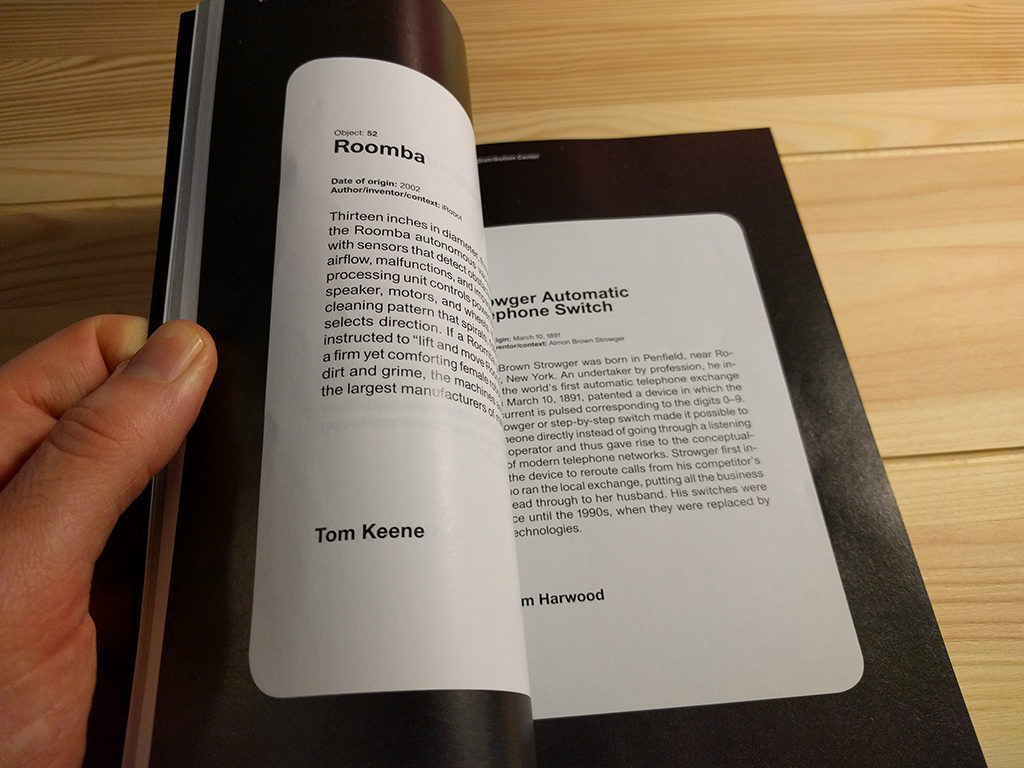
Likewise, Jussi Parikka’s chapter focuses on the question of time in the context of laboratory media and draws attention to the way that certain “time-critical technical media” (p.86) produce “micro-temporalities” that are irreducible to human perception (p.86). In producing a series of situated micro-temporalities, these laboratory media contribute to post-digital approaches to media more widely insofar as they allude to a sense of media time that exceeds humanity. Theorising the micro-temporalities of laboratory media is important because they are involved in fabricating and sustaining certain “situated practices” (p.87) of time that often exceed human perception (p.86) – a line of thought that will be familiar to those have read Parikka’s other contributions to developing a “geology” of media (Parikka, 2015).
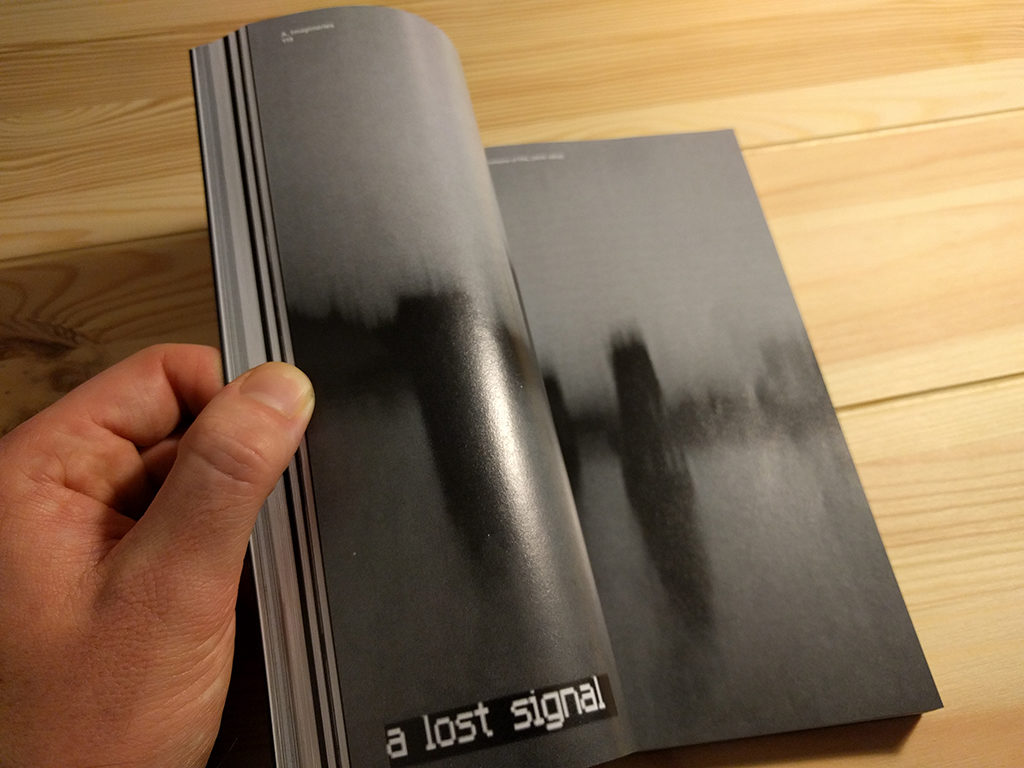
The second subsection – “Interventions” – foregrounds uses of technological media for activist and political purposes (see especially Dragona; de Lagasnerie; Oliver & Vasiliev; Sollfrank; Terranova; Juárez & Allen). In doing so, a number of chapters approach the politics of technological media through a critical engagement with its supposedly transformative power. As Jamie Allen – writing in dialogue with Geraldine Juárez’s artwork Hello Bitcoin – pointedly asks: “[w]hy is it that we cannot seem to stop regaling ourselves with hyperbolic, mythic tales of technological heroism?” (p.223). Put differently, how might media art and theory engage with ‘new’ digital media without overplaying its transformative political power? One answer to these questions revealed in across & beyond concerns the task of developing techniques for storying digital media. As Cornelia Sollfrank’s piece on “cyberfeminism” concludes, the task attending to the political power of technologies is not simply about affirming new advances in technological media, “but rather the use of imagination” (p.245): it is a task of remaking the clichéd stories told about technical cultures.
Yet, at a time when the drone and the TV series Black Mirror have gained prominence in invoking a certain unease about future technological change, what might it take to tell different stories about the political implications of technological culture? Decidedly, Daphne Dragona inflects this political question in a stellar essay on the role of “subversion” in media art. Classically, the problem of “artistic subversion” is its tendency to become appropriated into existing regimes of power, such as “media corporations and state surveillances agencies” (p.184). Identifying strategies that are already at work in “subversive” practices in media art – namely: “obfuscation”, “overidentification”, and “estrangement” – Dragona attempts the ambitious task of redefining the role of artistic subversion. Referring to an example of glitch artists, Dragona (p.191-192) notes that for such work processes of subversion and “estrangement” require a methodological approach attentive to the “hacks, errors and glitches” that “disrupt and challenge user experiences with digital media” (p.191).

Terranova’s chapter also considers how and whether the political power of technologies might offer opportunities for political transformation, but in doing so draws upon a different question around the relationship between the notion of the “commons” and certain kinds of “techno-political experiments” (p.211-215) – experiments that include, but are not limited to, certain cryptocurrencies and internet-based political parties. These experiments are noteworthy because they offer opportunities for transforming capitalist social, political and technical assemblages – assemblages that, as they are currently configured, not only produce restrictive forms of consumption and surveillance, but also limit freedoms at the level of desire through processes of subjectivation (p.213-217).
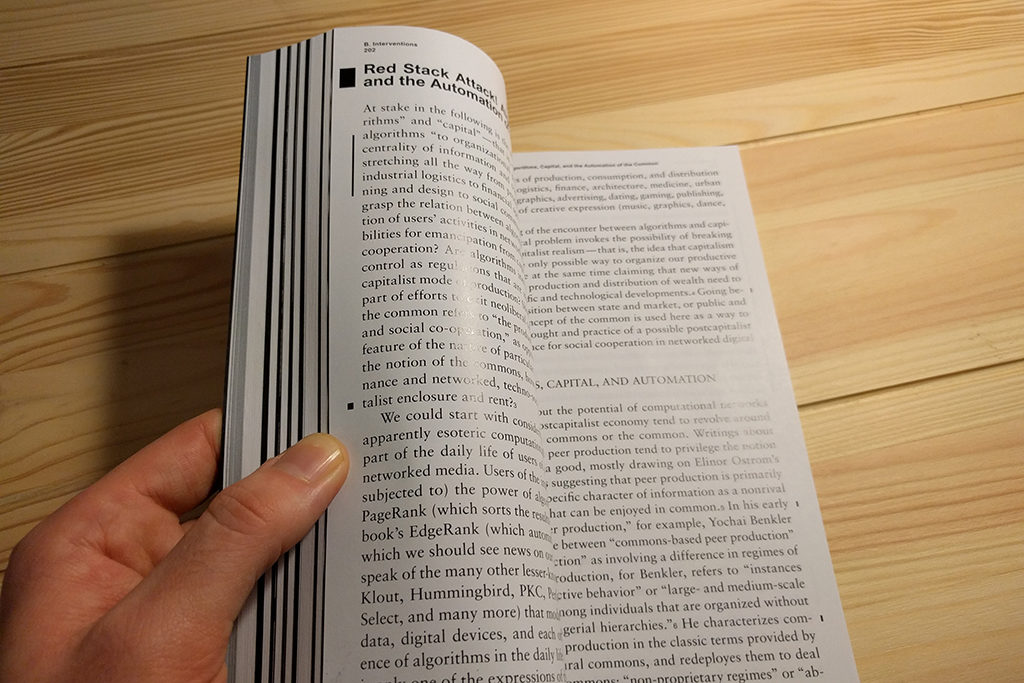
The third subsection – “Ecologies” – concerns the relationship between post-digital readings of technological media and certain kinds of technological infrastructure. In doing so it intervenes in a number of timely and ongoing social scientific debates about technology’s relationship to subjectivity (Bishop; Rossiter & Apprich; Bratton), materiality (Allen & Gauthier; Henderson; Goriunova), and affect (Goriunova; Allahyari & Rouke) – amongst others. Approaching the theme of infrastructure via user interfaces like Apple’s Siri and Amazon’s Alexa, Benjamin Bratton (p.322-323) notes that “[h]uman intelligence and machine intelligence may be radically different (one need not be the model for the other) but they are never isolated or independent of one another”. Bratton calls for a more complex reading of artificial intelligence that resists both the simple equivocation of human and machine ‘intelligence’, and the tendency to suggest that human or machine intelligence exists as an isolable entity.
Directly engaging with the question of post-digital approaches to technological infrastructure, Jamie Allen & David Gauthier – commenting on their Critical Infrastructure project – foreground the need to attend not only to spectacular forms of technological infrastructure, but also those “banal systems” (p.266) and infrastructures that “we are not supposed to notice” (p.266). The point here is to force media art and theory to generate new forms of critique and thought about technical culture beyond some of the tendencies of human perspectivism – what Morehshin Allahyari & Daniel Rourke’s chapter differently refers to as technology’s “unintended affects” (p.328).
One critical concern throughout across & beyond is the sense that the various contributions (artworks, films, photos, essays) do not always easily fit together as a contribution to post-digital scholarship and practice. Whilst the book benefits from a precise introduction, it is not always obvious how certain chapters, and their corresponding subthemes, critically engage with whether or not this field of study would be preferable to other approaches to digital media. Indeed, is the “digital” the problem to be addressed for the task of rethinking technical culture today or – as a moving composite expressed by numerous media – does it form what Deleuze (1988: 16-17) refers to as a “false problem”: that is, a problem that merely discovers pre-existing terms for its solution?
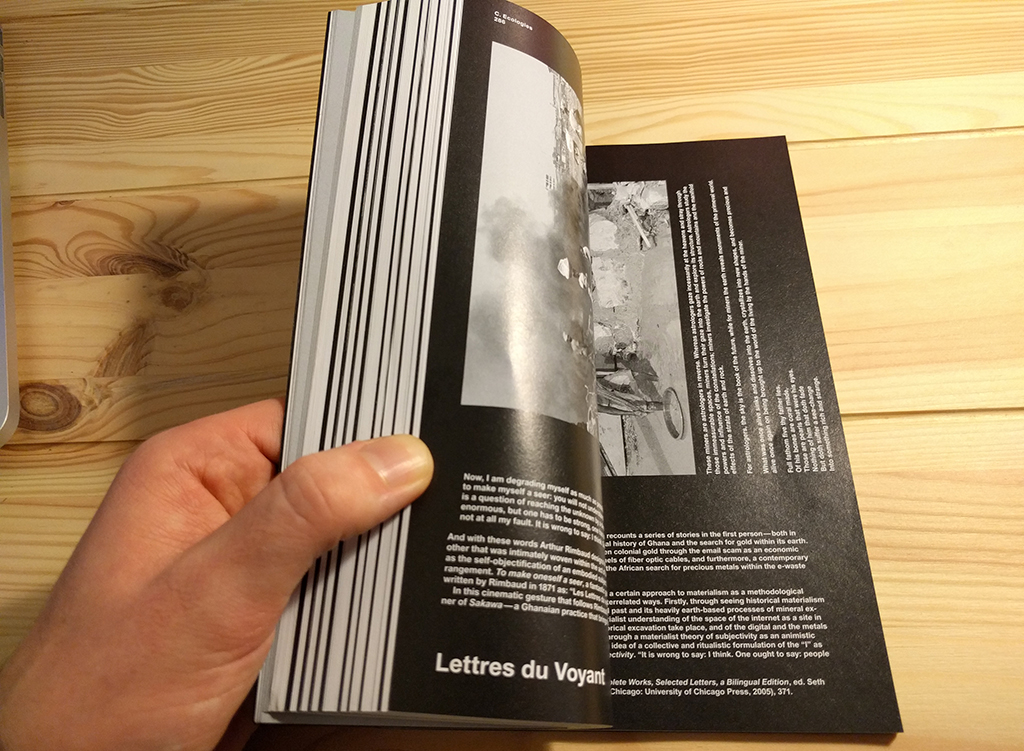
This critical question notwithstanding, and to conclude, across & beyond is highly successful in opening up novel questions about technological media: those mundane and overlooked technological processes that nonetheless offer opportunities for experimenting with profound mediations between humans and nonhumans (see here the chapter by Yokokoji & Harwood). These post-digital registers would engender a different focus from a recent emphasis in the arts, humanities and social sciences on the ways that certain dominant technological figures are variously weaponized and monetized (see chapter by Bazzichelli). In countering the logics of weaponization and monetization, this reader – like the transmediale festival – will have a wider appeal to those interested in how media art and theory keeps apace with changes to those overlooked forms of technical culture.
Featured image: Image from the movie ‘Frankenstein Conquers the World’ directed by Ishirō Honda, a 1965 Kaiju film.
“Nature builds no machines, no locomotives, railways, electric telegraphs, self-acting mules etc. … They are organs of the human brain, created by human hand; the power of knowledge, objectified.” [1] Marx (1857-8)
This writing roots out a few ideas concerning science and technological determinism and humanity’s bond with digital media and social networks. The themes are covered in terms loosely as to what they may symbolize. It looks at our fears relating to technology, human-machine relations, cyborgs, theories in cyber-culture, classical and SF literature and contemporary art practices across the fields of media art, hacktivism, activism, feminism and cyberpunk.
Mary Shelley’s Frankenstein is the focus for this text but it also brings into the mix, Greek mythology and Prometheus – the Titan, and what the myth symbolizes, asking, in what form does he exist in the world today? It is a playful assemblage of unresolved contemplations that have been sitting around asking for light in the back of my mind. This is a stripped down version of the original study about mythology, technology, fear and revolution.
Humans have always exploited the raw materials this planet has to offer, and has the power to change the nature of things, whether it is physical or virtual. With constant re-edits and enhancements we transform everything we touch and this is all part of our evolutionary mutation. [2] The word ‘technology’ originally comes from the Greek word tekhne, meaning art and craft, the making of useful or good things. The ‘ology’ part means to discuss something or a branch of knowledge and common form. In Greek Mythology Prometheus was a demigod and a Titan worshiped by craftsmen. “In Greece the Titans were ultimately honoured as the ancestors of men. To them was attributed the invention of the arts and magic.” [3] (Graves 1964)
First, we begin with an apocalyptic vision of what could be and what it looks like when something strange occurs in the oceans. In July 2011, an article in the International Business Times featured a phenomenon we’d normally expect in a science fiction novel or movie. The headline read “Millions of Jellyfish Invade Nuclear Reactors in Japan, Israel” [4] Then the Reuters news web site mentions another jellyfish invasion at a Scottish nuclear power plant, in Torness. “An invasion of jellyfish into a cooling water pool at a Scottish nuclear power plant kept its nuclear reactors offline on Wednesday, a phenomenon which may grow more common in future, scientists said.” [5]
On whether this occurrence is significant and poses future threats, the International Business Times said, “The several [power plant] incidents that happened recently aren’t enough to indicate a global pattern. They certainly could be coincidental, Monty Graham, a jellyfish biologist and senior marine scientist at the Dauphin Island Sea Lab off the Gulf Coast of Alabama stating, told LiveScience.” [7] However, some say jellyfish may be the only species worth fishing in European waters if trends in overfishing are allowed to continue. In an article in the Telegraph in 2008, it said, “scientists have said that unless the system is completely overhauled fish stocks will continue to deplete to the point of extinction by 2048, leaving consumers little option but to eat jellyfish or the small bony species left behind at the bottom of the ocean.” [8]
In September 2013 another mass of jellyfish forced one of the world’s largest nuclear reactors to shut down. The Operators of the Oskarshamn nuclear plant in Sweden had to scramble one of their three reactors after tons of jellyfish clogged the pipes that bring in cool water to the plant’s turbines. “By Tuesday, the pipes had been cleaned of the jellyfish and engineers were preparing to restart the reactor, which at 1,400 megawatts of output is the largest boiling-water reactor in the world.” [9]
“New research, published in the Proceedings of the National Academy of Sciences, shows that the rise in jellyfish populations may not only be aided by climate change, but is also contributing to it by making oceans more acidic, thereby disrupting their function as carbon sinks.” [10] (Land 2011)
Since the Chernobyl disaster in 1986 trust of a state’s handling of dangerous technology has taken a dive. We need only to look at Japan’s recent experience of technological disaster with their nuclear power stations. This brings us to the notion of risk and what this means. In the 19th Century risk was no longer about nature, it changed, it extended to us humans and our conduct. “This extension was due in part to the singular appearance of the accident, a kind of mix between nature and will.” [11] (Ewald 1993) […] Thus “no progress without associated damages.” [12]
Gareth Edwards, director of the 2014 Godzilla movie, starts with a 10 minute recap of “nuclear bomb tests from Bikini Atoll featuring voluminous apocalyptic mushroom clouds and a full-blown Fukushima-like nuclear power meltdown.” [13]

Since the 19th century fears about technology and the notion that scientists are meddling with creation itself has been in the public’s consciousness. Many view Mary Shelley’s Frankenstein as triggering these long-term concerns. Of course, these fears are subjective, but also include people’s concerns about not having control over how technological decisions are reshaping society. After all, many lives have been lost due to brilliant uses of technological advancement made specifically for the act of killing many, as with the development of nuclear and biological weapons.
“Two international treaties outlawed biological weapons in 1925 and 1972, but they have largely failed to stop countries from conducting offensive weapons research and large-scale production of biological weapons.” [14] (Frischknecht 2003)
Using biological and chemical weapons was condemned by international declarations and treaties, notably by the 1907 Hague Convention respecting the laws and customs of war on land. Efforts to strengthen this prohibition resulted in the conclusion, in 1925, of the Geneva Protocol, which banned the use of asphyxiating, poisonous or other gases, usually referred to as chemical weapons, as well as the use of bacteriological methods of warfare. [15]
“Let us now consider what happens when you make the epistemological error of choosing the wrong unit: you end up with the species versus the other species around it or versus the environment in which it operates.” [16] (Bateson 1972)

Mary Shelley’s Frankenstein has given us much to chew on, ranging across gender politics and history, including symbolic, political, psychological and social themes. Shelley was the daughter of writers Mary Wollstonecraft and William Godwin. Godwin is one of the forefathers of the anarchist movement and most famous for two books published within one year: An Enquiry Concerning Political Justice, an attack on political institutions, and Things as They Are; or, The Adventures of Caleb Williams, a novel that attacks aristocratic privilege, but also is the first mystery novel. Based on the success of these publications, Godwin was a prominent figure in the radical circles of London in the 1790s. [17]
Mary Wollstonecraft was a writer, philosopher, and advocate of women’s rights. During her brief career, she wrote novels, treatises, a travel narrative, a history of the French Revolution, a conduct book, and a children’s book. Wollstonecraft is best known for A Vindication of the Rights of Woman (1792), in which she argues that women are not naturally inferior to men, but appear to be only because they lack education. She suggests that both men and women should be treated as rational beings and imagines a social order founded on reason. Wollstonecraft died at the age of thirty-eight, ten days after giving birth to her second daughter, leaving behind several unfinished manuscripts. [18]
Mary Shelley’s publication, Frankenstein or The Modern Prometheus published in 1818, was perhaps the earliest representation of science fiction but it was also a gothic novel. Shelley appropriated the various influences and sources available to her at the time. Her novel is an assemblage of discoveries in science and technology, societal change and political upheavals, mixed with personal interests. In the 19th Century the Romantic poets, artists and writers Lord Byron, Percy Shelley and William Wordsworth explored ideas grounded in their shared rejection of Christianity. Percy Shelley in 1811, declared his rejection of a greater all-powerful being in The Necessity of Atheism saying, “It is easier to suppose that the Universe has existed from all eternity, than to conceive a being capable of creating it.” [19]
In 1817, Mary married Percy Shelley who became her second husband. They enjoyed debating many ideas together and had a passionate relationship. In the summer of 1816, a year before their marriage, Mary and Percy visited Claire Clairmont (Mary’s stepsister) in Switzerland, and also met Claire’s new lover Lord Byron and he was accompanied by a physician called John Polidori. During their stay at a nearby mansion Byron was renting next to the shore of Lake Geneva, they became good friends. Together, they all read volumes of German ghost stories, usually when the weather was too stormy for leisurely walks. Inspired by these ghost stories, Lord Byron issued a challenge for each of them to write their own tales of horror. All immediately began writing them out, however Mary struggled for inspiration taking Byron’s provocation seriously and listened to the various conversations the others had on the subject. Then, her ideas began to evolve once she had discussed at length the radical works of Dr. Erasmus Darwin with Byron. Darwin had experimented with electrical stimulation on dead matter, preserving a piece of vermicelli in a glass case “and by some extraordinary means it began to move…” [20] Hindle (2003)
Both of the Shelley’s were fascinated by Sir Humphry Davy’s publications Elements of Chemical Philosophy written in 1812 and A Discourse, Introductory to a Course of Lectures on Chemistry, 1802. Undoubtedly “the most celebrated and iconic figure of this entire Chemical Age was Sir Humphry Davy (1778–1829), who used his chemical discoveries, his wildly popular lecture series, and his general writings on science, to turn the ‘Chemical Philosopher’ (the term scientist not being coined until 1834) into a figure of social and cultural importance in a quite new way.” (Holmes 2012) more about Davy here link.
Percy Shelley in his youth “bought and experimented with chemical apparatus and materials and read treatises on magic and witchcraft, as well as more modern scriptures detailing the miracles of electricity and galvanism. [21] Mary Shelley was fascinated with the idea of things being brought back to life via electricity, and also studied the works of the Italian physiologist Luigi Galvini. [22]
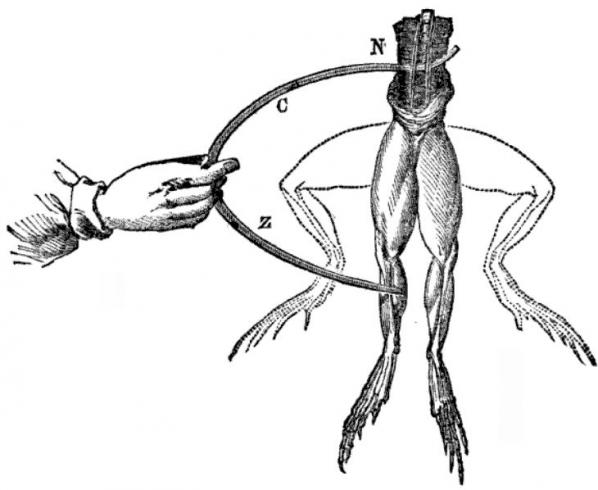
Galvini’s experiments convinced him that ‘animal electricity’ resided inside animal creatures. He observed that when using a circuit consisting of a piece of metal attached to the legs of a frog, convulsions would occur. He assumed the spasmodic jolts were an electrical fluid from within the nerves and muscles of the creature. This led to his announcement that he had brought the limbs of the animal back to life. An Italian physicist Alessandro Volta, who in 1800 made the Voltaic Cell, very soon disproved this. The SI unit of voltage is named after him. [23]
Even if creating life out of dead body parts is an unlawful and immoral proposition. Dr. Frankenstein has the whole of history and an extremely well heeled patriarchal system on his side. However, Shelley’s attack is not against all men but a particular type of man. “The first type is the Promethean scientist who uses nature to gain power and abusively alter it, and the second type is the ‘good’ scientist, who respects and celebrates nature and resists the temptation to fundamentally change the way it operates.” [24] (Munteanu 2001) Passages in Frankenstein reveal “Percy Shelley as the initial model for its ultra-ambitious hero, quite apart from the fact that Victory, Frankenstein’s first name Shelley took for himself a number of times in boyhood and later.” [25] (Hindle 2001)
The psychology expressed through the protagonist Dr. Victor Frankenstein is as a man who manages to transform his extreme, radicalized and revolutionary ideals into the form of a monster. This is a personal characterization informed by Shelley’s own experience with Percy Shelley and her father William Godwin. And, even though her love for them is evident, she also had deep concerns about their shared, revolutionary radicalism. Mary Shelley was well versed in the writings of her father Godwin and her mother Mary Wollstonecraft, as was Percy. They both systematically studied the works of Thomas Paine, and this included even conservative thinkers such as Edmond Burke, Abbe Barruel, John Adolphus. [26] (Sturrenburg 1982) Yet, Shelley’s “world view is less political than Godwin’s and Burke’s; it is also far more labyrinthine and involuted when it comes to telling us why things fall apart.” [27] (Ibid)
Prometheus 2.0.

Mary Shelley challenged the cliché narrative of the hero and his belief in the absolute. Her portrayal of Dr. Frankenstein as an egocentric obsessive who will stop at nothing until he completes his mission in bringing his creature to life; represents man’s blind quest in pushing on until the precarious end, at whatever cost. For Shelley, this indicates evident tensions between men and women and their scripted, dualistic roles. This may be an obvious feminist critique now, but in Shelley’s time it was a very different story. Wait a minute! Who am I kidding? The recent interview by Furtherfield’s Ruth Catlow on the New Criticals web site, with the multiple identity female artist(s) Karen Blissett tells us that we are still stuck in this arcane world of male domination. For Karen Blissett, her modern day Frankenstein’s exist in the everyday boardroom in managerial positions as they ‘move forward’ in pushing the top-down, and visionless austerity packages into all aspects of our everyday lives.
“Karen Blissett categorises her most recent artwork Senior Management, An Inspirational Guide, as art for offices […] they demand the impossible. Not in a good way, and not for the enrichment of human futures, but sucking up to power and policy makers – ministers, regulators, corporate leaders – negating their own experiences, demonstrating their loyalty through the implementation of trivial bureaucratic obligations.” [28]
This condition of biopolitics where society is being run by little men affirming their potency through the misleading, heroic trope of managing the life of others can be seen in different areas such as in the military, war, slavery, in education, the media, the economy, religion, technology and science, sex trafficking; on the whole, it is his business to inherit all these power systems from birth. Foucault first mentioned biopolitics on 17 March 1976, during his “Society Must Be Defended” lectures. He described it as a new technology of power and that it exists at a different level, on a different scale, and that it has a different bearing area, and makes use of very different instruments. Foucault’s biopolitics acts as a control apparatus exerted over a population as a whole or, as Foucault stated, “a global mass.” [29]
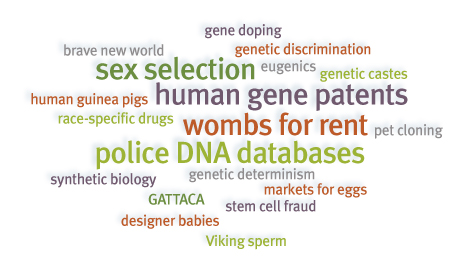
Karen’s monster is neoliberalism, a monster administered by millions of Frankensteins, feeding a globalized monster consisting of networks, machines, weaponry, surveillance, financial control, and elite groups. Keith Fisher in an article called ‘Frankenstein’s Bankers’ on The Global Dispatches web site said “Just as Dr. Frankenstein was responsible for creating a tragic human monster, so are we collectively ultimately responsible for our severely dysfunctional financial system and the activities of its bankers.” [30]
If we take a look at Facebook we can observe that it is an open and free (to use) platform for all, on the Internet. However, the relationship between users and the platforms of Facebook and Twitter are exploitative. In that they treat social media users as consumers of technological services and producers of data, commodities, value and profit. As Simon Penny points out in his essay ‘Consumer Culture and the Technological Imperative’, “One of the classic techno-utopian myths of computers is that access to information will be a liberation, and the results will be, by definition, democratizing.” [31] (Penny 1995) His critique on networked technology and the dreams it once promised us, can now be clearly seen as in dire trouble. Everyday there is a new story about how NSA and Prism are spying on Internet users on mass, Julian Assange sees this as the militarization of cyberspace. [32] (Assange 2012)
SF can pull us into imaginary settings, in the past, present and future, while relating to scientific or technological advances. Some SF looks at major social and environmental changes or portrays space and time travel, and life on other planets. SF has been a generous gift to the world via the minds of original thinkers, showing us a playful side in dealing with the social contexts of technological determinism. It is a third space or outer region where our imaginations can open up different ways to try and understand scientific and technological impacts on society. It is a place where anything goes whether it relates to reality or not. In contrast to the heroic male warrior who is swashbuckling against a mass of aliens to save the world from total extinction or a large-scale catastrophe. Women’s SF has mainly expressed its cultural identity by using “the figure of the alien to describe systems of difference and domination,” [33] (Flanagan & Booth 2002) and Women’s SF and cyberfiction combines exploring the creation of an alien, as the ‘other’. Representing ‘her’ own collective states of alienation in a world consisting of structures maintaining patriarchal dominance, with the female as a techno-product for men to control for their own sexual, financial, administered and power related needs.
Women’s cyberfiction deals with inclusion of the female in societal frameworks where traditionally the male’s tools for engineering, building and use of machinery typically reflect their own practical needs and an industrial and techno-culture designed for them selves. “This dominant class, which is exclusively white and male, operates on a logic of profit and maintaining their control over society, […] it is also shared by white working-class and minority men who are not so well served by it…” [34] (Benston 1992) While many women have jumped into the SF and cyberfiction field they have somehow bypassed the spectacle of techno-utopian rhetoric.
Alongside the growth of technology we are experiencing similar anomalies as with the jellyfish invasions. It is a period where fantasy and reality and the boundaries which once separated them, are breaking up. It’s as if the natural world has now caught up with it’s own version of a post-modern realization. Reflecting back at us a psychosis into material form, the dysfunctional and nihilistic relationship we’ve had with it since our emergence as a race on this planet. Monsters have always demarcated the limits of human folly, telling us when we have pushed things too far. Whether in the form of Godzilla, a nuclear explosion, mutant jellyfish, a war, mining the earth’s resources, and drone technology, spying networks or Frankenstein; they are poignant symbols screaming back at us a painful message. As all the disasters humanity has created pile up, if nature could talk to us in another way and not in the form of our own making – the language of disaster. What would it say and would we even listen?
However, some are recognizing the cultural value of neoliberal monsters. In an interview with Tatiana Bazzichelli on Furtherfield, we discussed her publication Networked Disruption: Rethinking Oppositions in Art, Hacktivism and the Business of Social Networking. Bazzichelli puts forward the notion of disruptive business and that it “becomes a means for describing immanent practices of hackers, artists, networkers and entrepreneurs”, and sheds “light on two different but related critical scenes: that of Californian tech culture and that of European net culture – with a specific focus on their multiple approaches towards business and political antagonism.” [35]
“Monsters have always defined the limits of community in Western imaginations. The Centaurs and Amazons of ancient Greece established the limits of the centred polis of the Greek male human by their disruption of marriage and boundary pollutions of the warrior with animality and woman. Unseparated twins and hermaphrodites were the confused human material in early modern France who grounded discourse on the natural and supernatural, medical and legal, portents and diseases — all crucial to establishing modern identity. The evolutionary and behavioural sciences of monkeys and apes have marked the multiple boundaries of late twentieth century industrial identities. Cyborg monsters in feminist science fiction define quite different political possibilities and limits from those proposed by the mundane fiction of Man and Woman.” [36] (Haraway 1991)
Patchwork Girl was a hypertext fiction created Shelley Jackson in 1995. It is a retelling of the story of Frankenstein. The emphasis is about appropriation and transformation and the female monster is completed, or rather assembled by Mary Shelley herself. “The conflict highlights the monster’s nature as a collection of disparate parts. Each part has its story, and each story constructs a different subjectivity. What is true for the monster is also true for us, Jackson suggests in her article “Stitch Bitch: the Patchwork Girl.” “The body is a patchwork,” Jackson remarks, “though the stitches might not show. It’s run by committee, a loose aggregate of entities we can’t really call human, but which have what look like lives of a sort… [These parts] are certainly not what we think of as objects, nor are they simple appendages, directly responsible to the brain” [37] (Hayles 2000)
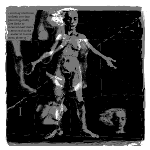
Karen Blissett and Patchwork Girl both express more than one part or selves. Haraway proposes that, “The proper state for a Western person is to have ownership of the self, to have and hold a core identity as if it were a possession.” [38] (Haraway 1991) And that “Not to have property in the self is not to be a subject, and so not to have agency.” [39] (Ibid) Blissett is a living collective of female activists expressing themselves as part of a multitude critiquing male dominance and neoliberalism directly.
So, can we re-mutate ourselves in order to loosen the stranglehold of these neoliberal defaults and forge new or alternative states of agency and psychic freedom? Bazzichelli, says “we should stop looking for the enemy, because who is the enemy today when disruption and its opposition are feeding the same machine?” [40] I do not see it as us feeding the same machine in the absolute sense. Sometimes breaking the loop can be more inline to finding meaning and values with others, and yes this can be difficult. But it does not mean that it’s the wrong thing to do.
For me, Bazzichelli’s proposition is an ideal situation if you are not suffering from pressing societal upheavals. As Blissett points out, there are urgent social situations that need attention. Of course, there are those who’ve fallen so deeply into the void of no return, they will happily serve or become a Prometheus monster without a glimmer of soulful insight. Yet, there is always hope for humanity and the artists and thinkers we’ve explored here have proven this. If this article is about anything it is about how the imagination can forge out new ways in becoming something different than the script we’ve been given. The spirit of the Shelleys, Bazzichelli, the Karen’s, Haraway and Jackson, show us that alternatives are out there available for exploration while at the same time we can still maintain our dignity.
References:
[1] Karl Marx. Grundrisse: Foundations of the Critique of Political Economy. Penguin Classics; New Ed edition (29 April 1993). Martin Nicolaus (Translator). Page 706.
Note: Written during the winter of 1857-8, the Grundrisse was considered by Marx to be the first scientific elaboration of communist theory. A collection of seven notebooks on capital and money, it both develops the arguments outlined in the Communist Manifesto (1848) and explores the themes and theses that were to dominate his great later work Capital. Here, for the first time, Marx set out his own version of Hegel’s dialectics and developed his mature views on labour, surplus value and profit, offering many fresh insights into alienation, automation and the dangers of capitalist society. Yet while the theories in Grundrisse make it a vital precursor to Capital, it also provides invaluable descriptions of Marx’s wider-ranging philosophy, making it a unique insight into his beliefs and hopes for the foundation of a communist state.
[2] Note: The words ‘evolutionary mutation’ refer to ‘technology’ as a default changing process. This includes the constant appropriation and reinvention of human cultures; altering our psychology, perceptions, traits, anatomy, physiology, our DNA, individual and collective behaviour, relations with: objects, machines, work environments, leisure, tools, tribalism, domestic habits and changing attitudes.
[3] Robert Graves. Larousse Encyclopedia of Mythology. Paul Hamlyn, London. 5th Edition, 1964. P.92.
[4] Article. Millions of Jellyfish Invade Nuclear Reactors in Japan, Israel. IBTimes. Jul 09, 2011.
http://www.ibtimes.com/articles/177027/20110709/millions-jellyfish-invade-nuclear-reactors-japan-israel-2011-power-plant-shut-down-unusual-growth-tr.htm
[5] Jellyfish keep UK nuclear plant shut. Jun 29, 2011.
http://www.reuters.com/article/2011/06/29/us-britain-nuclear-jellyfish-i…
[6] Millions of Jellyfish Invade Nuclear Reactors in Japan, Israel (PHOTOS). 9 July 2011.
http://www.ibtimes.com/millions-jellyfish-invade-nuclear-reactors-japan-israel-photos-707770
[7] Ibid.
[8] Jellyfish on the menu as edible fish stocks become extinct. The Telegraph. Louise Gray, Environment Correspondent. 15 Dec 2008.
http://www.telegraph.co.uk/earth/3776788/Jellyfish-on-the-menu-as-edible-fish-stocks-become-extinct.html
[9] Jellyfish Cluster Shuts Down Nuclear Reactor. Sky News, 1 October 2013
http://news.sky.com/story/1148872/jellyfish-cluster-shuts-down-nuclear-reactor
[10] Are we entering ‘The Age of the Jellyfish’? Graham Land. Jun 13th, 2011. Greenfudge.
http://bit.ly/1jOMXrw
[11] Francios Ewald. Two Affinities of Risk. The Politics of Everyday fear. Brian Massumi, editor. University of Minnesota Press. 1993. P.226.
[12] Gareth Edwards, director of the 2014 Godzilla – find link
[13] Ibid P.226.
[14] Friedrich Frischknecht. Human experimentation, modern nightmares and lone madmen in the twentieth century. EMBO Rep. Jun 2003; 4(Suppl 1): S47–S52. Science and Society. http://www.ncbi.nlm.nih.gov/pmc/articles/PMC1326439/
[15] Efforts to ban biological weapons.
The latter are now understood to include not only bacteria, but also other biological agents, such as viruses or rickettsiae which were unknown at the time the Geneva Protocol was signed. However, the Geneva Protocol did not prohibit the development, production and stockpiling of chemical and biological weapons. Attempts to achieve a complete ban were made in the 1930s in the framework of the League of Nations, but with no success.
[16] Gregory Bateson. Steps to an Ecology of Mind. Anthropology, Cybernetics. Publisher: University of Chicago Press. 1972. P491-2.
[17] Bertrand Russell. A HISTORY OF WESTERN PHILOSOPHY And Its Connection with Political and Social Circumstances from the Earliest Times to the Present Day. Chapter VI. The Rise of Science. Page 512. Allen & U.; New impression edition (Dec 1961).
[18] Percy Bysshe Shelley. The Necessity of Atheism. C. and W. Phillips in Worthing. 1811.
[19] Note: Erasmus Darwin (12 December 1731 – 18 April 1802) was an English physician who turned down George III’s invitation to be a physician to the King. One of the key thinkers of the Midlands Enlightenment, he was also a natural philosopher, physiologist, slave trade abolitionist, inventor and poet. His poems included much natural history, including a statement of evolution and the relatedness of all forms of life. He was a member of the Darwin–Wedgwood family, which includes his grandsons Charles Darwin and Francis Galton. Darwin was also a founding member of the Lunar Society of Birmingham, a discussion group of pioneering industrialists and natural philosophers. http://en.wikipedia.org/wiki/Erasmus_Darwin
[20] Maurice Hindle (Editor). Frankenstein or The Modern Prometheus. Mary Wollstonecraft (Godwin) Shelley. Publisher: Penguin Classics (May 6, 2003). Revised edition, Maurice Hindle (Editor) Author’s Inroduction. P. 8.
[21] Ibid P.8.
[22] Note: Luigi Galvani. During the 1790s, Italian physician Luigi Galvani demonstrated what we now understand to be the electrical basis of nerve impulses when he made frog muscles twitch by jolting them with a spark from an electrostatic machine.
[23] Alessandro Volta. Oxford Dictionary of Science. Sixth Edition. Oxford University Press, 2010.
[24] Anca Munteanu. Shelly’s Frankenstein. Commentary by Anca Munteanu Ph.D. Edited by Dr. Stephen C. Behrendt. CliffsComplete published by Hungry Minds 2001. Chapter 3. P.53.
[25] Maurice Hindle. Frankenstein or The Modern Prometheus. Mary Wollstonecraft (Godwin) Shelley. Publisher: Penguin Classics (May 6, 2003). Revised edition. P.XXIV (24).
[26] Lee Sturrenburg. Mary Shelly’s Monster: Politics and Psyche in Frankenstein. The Endurance of Frankenstein. Edited by George Levine and U.C. Knoepflmacher. University of Californian Press. 1982. P.153.
[27] Ibid P.157.
[28] Karen Blissett is Revolting. Interview by Ruth Catlow. New Criticals May 24, 2014. http://www.newcriticals.com/karen-blissett-is-revolting/print
[29] Biopolitics. http://en.wikipedia.org/wiki/Biopolitics
[30] Frankenstein’s Bankers By Keith Fisher. The Global Dispatches. November 26, 2013.
http://www.theglobaldispatches.com/articles/frankensteins-bankers
[31] Simon Penny. Consumer Culture and the Technological Imperative. Critical Issues in Electronic Media. State University of New York Press. Editor, Simon Penny. 1995. P.63.
[32] The Militarisation of Cyberspace. Publication — Cyperpunks: Freedom and the Future of the Internet. Julian Assange, Jacob Appelbaum, Andy Moller-Maguhn and Jereme Zimmerman. Or Books, New York and London. (2012) P.33.
[33] Mary Flanagan and Austin Booth. Reload: Rethinking Women and Cyberculture. The M.I.T Press. Cambridge, Massachusetts, London England. 2002. P.31.
[34] Margaret Lowe Benston. Article 1.2. Women’s Voices/men’s Voices: Technology As Language. Publication – Inventing Women: Science, technology and Gender. Edited by Gill Kirkup and Laurie Smith Keller. Polity Press, 1992. P.35.
[35] We Need to Talk About Networked Disruption, Art, Hacktivism and Business: An interview with Tatiana Bazzichelli. By Marc Garrett – 13/02/2014.
http://www.furtherfield.org/features/interviews/we-need-talk-about-networked-disruption-and-business-interview-tatiana-bazzichel
[36] Donna Haraway. Simians, Cyborgs, and Women: The Reinvention of Nature. Free Association Books. 1991. P.180.
[37] Flickering Connectivities in Shelley Jackson’s Patchwork Girl: The Importance of Media-Specific Analysis. N. Katherine Hayles. 2000.
http://pmc.iath.virginia.edu/text-only/issue.100/10.2hayles.txt
[38] Donna Haraway. Simians, Cyborgs, and Women: The Reinvention of Nature. Free Association Books. 1991. P.135.
[39] Ibid P.135.
[40] We Need to Talk About Networked Disruption, Art, Hacktivism and Business: An interview with Tatiana Bazzichelli. By Marc Garrett – 13/02/2014.
http://www.furtherfield.org/features/interviews/we-need-talk-about-networked-disruption-and-business-interview-tatiana-bazzichel
[41] Karen Blissett is Revolting. Interview by Ruth Catlow. New Criticals May 24, 2014. http://www.newcriticals.com/karen-blissett-is-revolting/print
Post Digital Print
The Mutation of Publishing Since 1894
Alessandro Ludovico, 2012
Onamatopee 77
The sticky fingerprints on the black-and-pink 1970s photomechanical typography-style lettered cover of “Post Digital Print” speak volumes about the nature of physical print after the event of digital typography. It is this sense, of print in a state of technical and historical play after the full event of the digital rather than its end or irrelevance, that Alessandro Ludovico is considering history of print publishing here. But why 1894?
Ludovico dates the first announcement of “the death of print” to that year. More than a century later independent bookshops, large bookshop chains, newspapers and magazines are having to compete with Internet-based publishing or be wiped out. It’s not clear whether physical print publishing believes it can survive this encounter with the digital. Ludovico explains how it can and why it is important that it should.
There are three main threads to “Post Digital Print”. The first is a wide-ranging technical history of print, including technologies that were imagined or proposed but never became widespread. The second is a history of radical political and avant-garde historical use, misuse and critique of those technologies. And the third is an analysis of the social and technological networks that distributed the products of the first two. These threads tie together finally in a consideration of the current situation and future prospects of physical print publishing.
The mainstream history of printing goes from movable type through hot metal to photomechanical and finally PostScript-based publishing. This is how books and newspapers have reached millions of people. But not every print production technology has lasted or gained mass adoption. I was surprised to read that Ezra Pound once wrote a poem specifically for Bob Brown’s “Readies” (an imagined 1930s motorized-paper-strip book replacement), and in the first half of the twentieth century newspapers were transmitted by telegraph, telephone and radio ready to be listened to or remotely printed.
The technical failings of dead media become aesthetic affordances in their afterlives. Letterpress embosses the paper it is printed on, lithography suffers misregistration and other artifacts, and newsprint smears and creases. These are now the very qualities people seek from those media. This is different from mere nostalgia, in that it is used to create a contemporary aesthetic, but what of the “Readies” and other book replacements that never were? They are the subconscious or the dreams of print technology, forgotten futures that help to understand the paths that were taken.
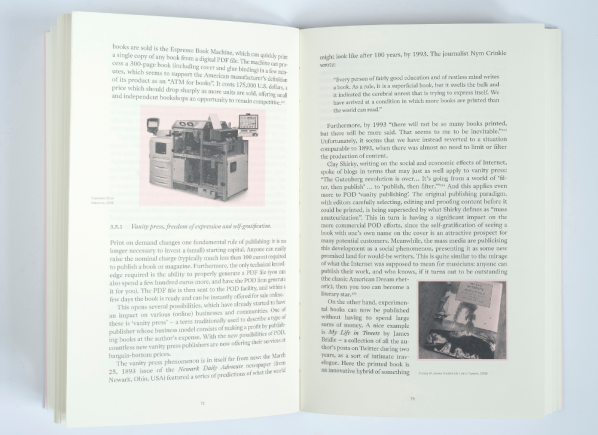
Not every print technology was designed to print millions of copies. Spirit duplicators, photocopiers and print-on-demand publishing all allowed democratic access to print for smaller print runs of projects with less mass appeal. Ludovico tracks this thread of print history from mid-twentieth-century science fiction fanzines through the alternative press to the contemporary fanzine scene.
Artists and political groups pushed the technology and aesthetics of each new print technology with pamphlets, unlicensed newspapers, the alternative press, fanzines, and books and journals. Ludovico uses avant-garde and culture jamming artistic publications, from the Dadaists and Futurists to the Yes Men and Decapitator to demonstrate how artists have pushed the form and content of print publications.
Once you have printed a publication you must distribute it. For publications outside of mainstream or official culture, this is a task that has varied in difficulty from inconvenient to deadly. British newspapers had to be licensed (and thereby censored) by the state in the early nineteenth century. Alternative political views were printed in unlicensed newspapers printed by sympathetic printers. These newspapers outsold the official press, and were subject to repression by the state, leading to funds being set up to support the families of arrested printers.
In the Soviet union, Samizdat copies of books were produced with stolen or smuggled paper and borrowed presses. Less dramatically but still outside the mainstream or official culture, the alternative press and fanzine scenes have survived through mail-order print and online catalogues and through conventions. And the Fluxus scene distributed its print products through an international network of distributors.
The “gesture” of publishing, as Ludovico calls it, is an editorial one and without this editorial control the Internet of blogs and social media presents a problem of filtering rather than access. Writing from the web can be taken into print cheaply through print-on-demand, led by the example of James Bridle’s “My Life In Tweets”, 2009. Where an artist led, business followed and there are now many services that will print your social media as books for you.
(What of eBooks? Ludovico considers their technology and its history in depth, but is not hopeful for them. They simulate print ever more closely, confirming Ludovico’s argument that print is the better interface. They have an environmental impact that makes books look more appealing, and suffer all the problems of censorship and technological obsolescence that print now does not.)

In the final chapter (“The Network”) the author enters the story that he is telling. Since the early 1990s Ludovico has produced the magazine “Neural” (I’m a subscriber and I cannot recommend it highly enough), and has been involved in other art projects, events and interventions that have placed him in the thick of the action of the changes in publishing and textual media that have occurred over this period. Rather than affect a false objectivity, Ludovico lets you know where he is coming from and shares the particularities of his broad experience. This lends his conclusions a context and authority that mere theory might lack.
The history and experience that Ludovico lays out leads to the present crisis of print and answers it with the terms that he has established. How can we continue to print physical books? With the kinds of networks that have always propagated and paid for art and for the alternative press. Why should we continue to make them? Because they are better interfaces, archives, and art objects than purely digital objects.
Post-digital print is print with its production and in some ways its very meaning transformed. Print must adopt digital-inspired models of production and distribution to survive. As Ludovico argues it must adopt the digital strategy of the network, in a free and open way. If it does not, we lose a vital part of our collective cultural voice and memory.
“Paper is flesh, screen is metal. … Flesh and metal will thus merge as in a cyberpunk film, hopefully spawning useful new models for carrying and spreading unprecedented amounts of information and culture.” (Post-Digital Print, p117)
The text of this review is licenced under the Creative Commons BY-SA 3.0 Licence.
(Thank you to Freek Lomme of Onomatopee for providing the book interior images.)